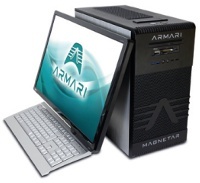Why you can trust Creative Bloq
PRICE: £1,511 / $1,800
MAIN FEATURES:
- DirectX 11
- OpenGL 4.3
- Shader Model 5.0
- 1,536 CUDA processing cores
- 4GB GDDR5 RAM
- 2 x DisplayPort
- DVI-I, DVI-D
- 4,096 x 2,160 resolution (DisplayPort 1.2)
MANUFACTURER: Nvidia
Nvidia launched its Fermi generation of Quadro professional graphics cards over two years ago. Although the range still stands up well, two years is a long time in the world of integrated circuits. There have been two generations of Intel processors in that time, for example, and AMD launched its W series of FirePro cards earlier this year. So, at long last, we can formally introduce you to Nvidia’s Kepler generation.
Kepler is currently only available in the Quadro K5000, which essentially replaces the Quadro 5000. If you’re selective with your reading of the specification, the K5000 will wipe the floor with the 5000, and every Quadro that went before it. Where the 5000 has 352 CUDA processing cores, the K5000 has a gobsmacking 1,536. But things aren’t quite that simple – and an explanation of the theoretical processing throughput is required.
The Quadro 5000 is capable of 718 gigaflops of single-precision processing, where the K5000 manages a huge leap to 2,150 gigaflops. However, the story is the complete opposite when it comes to double-precision (64-bit) processing, with the Quadro 5000 achieving 359 gigaflops, while the K5000 can only muster 90 gigaflops. These figures should be contrasted with AMD’s recent FirePro W8000, which can produce 3.23 teraflops of single-precision and 806 gigaflops of double-precision performance. For the majority of 3D work, however, the single- precision increase will far outweigh the drastic fall in double-precision figures.
BENCHMARK TESTS

We tested the K5000 in Armari’s Magnetar M32-AW750R, giving us a direct comparison with the AMD FirePro W9000 – which is a little more expensive but broadly comparable in the target market. The K5000 managed 87.36 in the OpenGL portion of Maxon Cinebench R11.5, compared with the W9000’s 74.19.
SPECviewperf 11 results were even more impressive, with the K5000 managing 77.33 in catia-03 compared with 21.14; 75.41 in ensight-04 compared with 55.11; 72.06 in lightwave-01 compared with 51.97; and 118.17 in maya-03 compared with 53.19. So the K5000 beats the W9000 across the board, and by significant quantities in the all-important 3D modelling viewsets lightwave-01 and maya-03.
We ran the same Bunkspeed CUDA-enhanced rendering test as we did for Boston’s Tesla-powered Venom 2300-7T. The test scene took 154 seconds with the CPU alone – almost the same as the Venom – which fell to 106 seconds with the K5000 helping out. However, the Venom took 72 seconds with the Tesla and Quadro 4000, implying that the K5000’s modelling abilities aren’t quite as stunning for CUDA-powered rendering.
We also tested the K5000 with Windows 8. Scores were mostly comparable, but a few SPECviewperf viewsets were behind the Windows 7 results, in particular 61.78 in catia-03, 12.42 in proe-05 and 53.45 in tcvis-02. So sticking with Windows 7 until drivers are optimised would appear to be the safest option.
Overall, the Nvidia Quadro K5000 is a significant new release for 3D content creators. It’s the fastest card for modelling on the market in every test we’ve tried, by quite some margin. As a CUDA or OpenCL co-processing unit, however, the K5000 isn’t such a clear winner. For 3D rendering it can offer a valid contribution, but any application requiring double-precision grunt should be run on different hardware.
PROS
- Fastest 3D accelerator for modelling
- Boost for CUDA-based 3D rendering
- Comparatively reasonably priced
CONS
- Lower 64-bit processing than Fermi cards
- Not ideal as a scientific CUDA co-processor
The Nvidia Quadro K5000 showcases Kepler’s modelling abilities but shows that it’s not ideal as a CUDA co-processor
RATING: 4
About the author
James Morris has tracked the rise of every new development, from OpenGL accelerators to multiprocessor workstations, over more than 15 years of testing 3D content creation hardware
The Quadro K5000 was tested on the mighty Armari Magnetar M32-AW750R.

Thank you for reading 5 articles this month* Join now for unlimited access
Enjoy your first month for just £1 / $1 / €1
*Read 5 free articles per month without a subscription

Join now for unlimited access
Try first month for just £1 / $1 / €1

The Creative Bloq team is made up of a group of art and design enthusiasts, and has changed and evolved since Creative Bloq began back in 2012. The current website team consists of eight full-time members of staff: Editor Georgia Coggan, Deputy Editor Rosie Hilder, Ecommerce Editor Beren Neale, Senior News Editor Daniel Piper, Editor, Digital Art and 3D Ian Dean, Tech Reviews Editor Erlingur Einarsson, Ecommerce Writer Beth Nicholls and Staff Writer Natalie Fear, as well as a roster of freelancers from around the world. The ImagineFX magazine team also pitch in, ensuring that content from leading digital art publication ImagineFX is represented on Creative Bloq.
